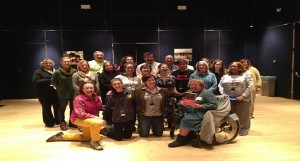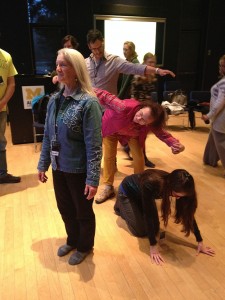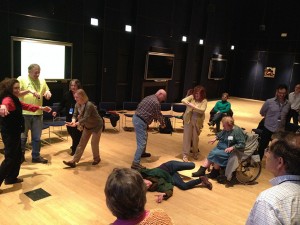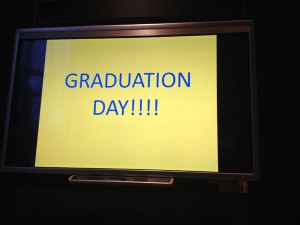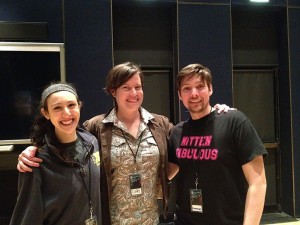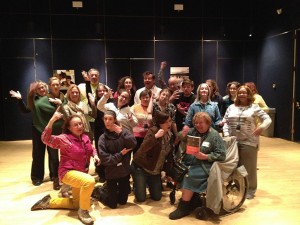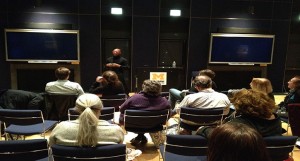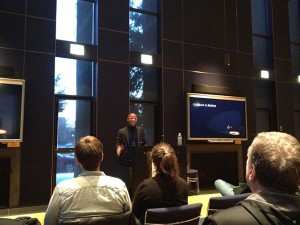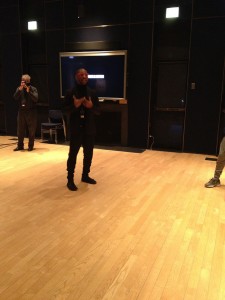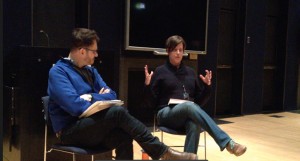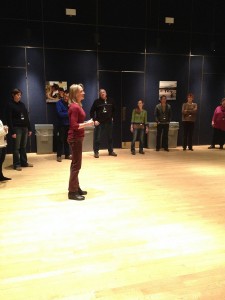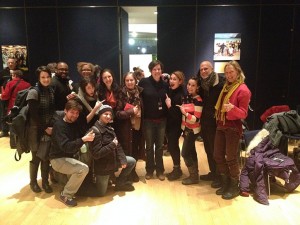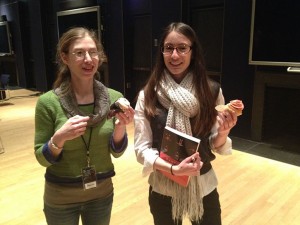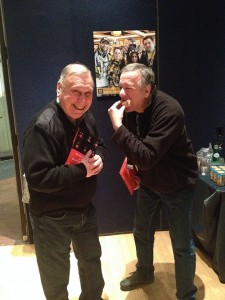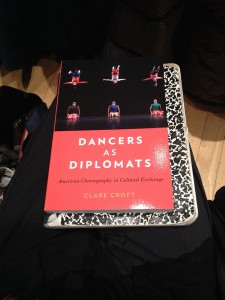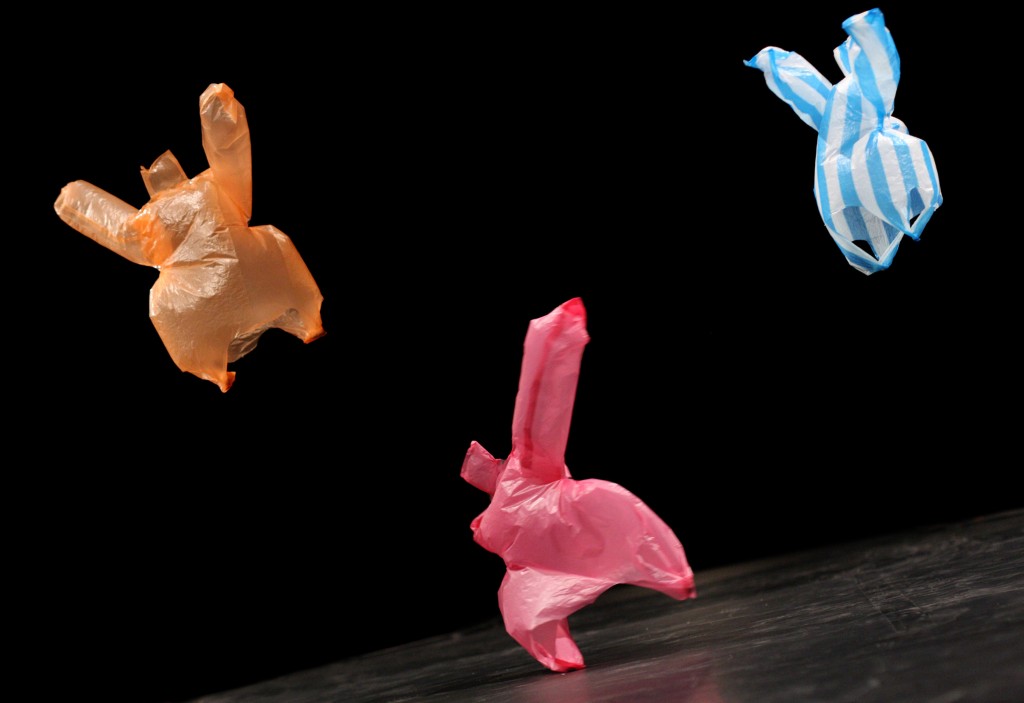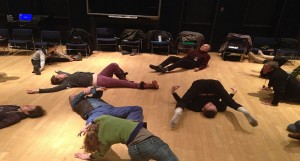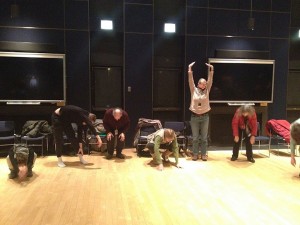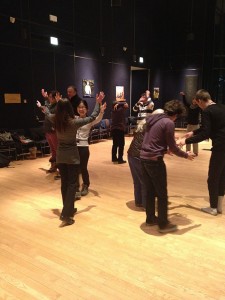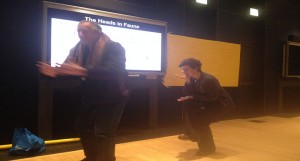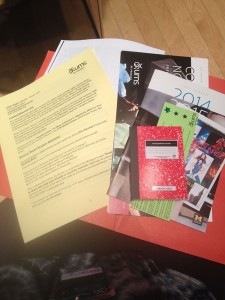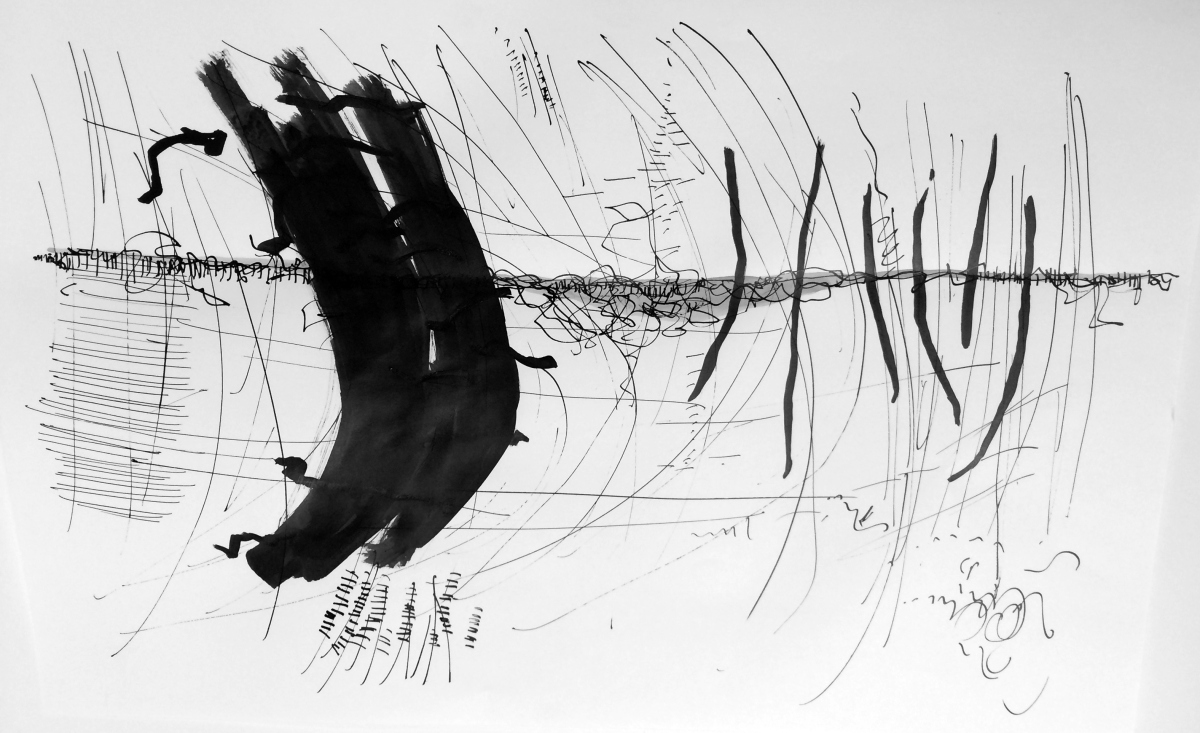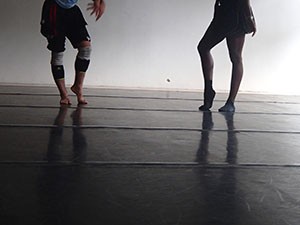Artist Statement: Javaad Alipoor on ‘Things Hidden’

Things Hidden Since the Foundation of the World is the final part of a trilogy of shows that began in 2017. At the heart of this trilogy has been a single thread: the relationship between contemporary technology and contemporary politics.
My idea was that the relationship between contemporary technology and contemporary politics is revealing things about how our minds work, and that to try and get to grips with what is going on in the world today, we have to understand, at the same time, how we train ourselves to think about them.
Each part of the trilogy has tried to refract this idea through different lenses. The Believers Are But Brothers, the first part of the trilogy, used instant messaging technology like WhatsApp to think about masculinity, extremism, and the Internet. Rich Kids: A History of Shopping Malls in Tehran used Instagram and video messaging to explore the Anthropocene, the growing gap between the rich and the poor, and the collapsing promise of the 20th century’s moments of revolution. This final part uses Wikipedia and murder mystery podcasts to confront the way the world seems to be moving closer together, at the same time that we find it harder and harder to understand each other.
At its heart is a true story. The unsolved murder of Fereydoun Farrokhzad, an iconic Iranian pop star, living as a refugee in Germany in the early 1990s.
When I first began work on it in the middle of the pandemic it had a certain context. At its heart, it’s a piece about the responsibilities that people in richer and more democratic countries have towards people and countries who are fighting for more democracy. And this necessitates it also being about translation. Too often, people in our part of the world, problematically grouped together as the West, use the rest of the world as examples that flesh out their preconceived ideas about how things work.
On the right they want to claim that the world would be fine if everyone followed their example; and on the left they want to say that the West is the font of all evil. But the reality of the countries at the forefront of this struggle, whether Iran, Hong Kong, Syria, or Ukraine, is that they upend such preconceived notions. It needs to stop putting ourselves at the center.
So while Things Hidden Since the Foundation of the World is in part a sort of protest song about the murder of Fereydoun Farrokhzad, it’s also about how we try and process stories like that.
It’s about the possibility of political and social solidarity in a world of superhuman complexity and interconnectedness. It’s about the thousands of ways that our brains, our devices, and our histories seduce us into simplification or terrify us into inaction. It’s about the feeling of being both overstimulated and stuck, and it’s about the bravery we need to abandon all that.
As the trilogy has developed, the level of ambition that I’ve tried to bring to it has grown, too. Collaboration has been key to all these works, and in this show, the team has been bigger and more talented than ever before. As well as the performers and creatives you see on stage and operating the show, the project would not have happened without the initial conversations I had with my co-creator, dramaturge, and partner Natalie Diddams. The co-writing relationship with Chris Thorpe that resulted in the script we perform has come out of five years of working together.
The first part of this trilogy received its US premiere here at Ann Arbor as part of the No Safety Net festival in 2020, and so it feels like an honor to share this final part with the unique community around UMS.
— Javaad Alipoor
Experience Things Hidden Since the Foundation of the World, Nov 15-18 at the Arthur Miller Theatre.
How Isango Ensemble and Shows Like ‘Hamilton’ Integrate Audiences

Finding new context for stories within a South African township setting, Cape Town-based theatre company Isango Ensemble makes its UMS debut this October 16-20 in two programs: The Magic Flute and A Man of Good Hope.
 In her 2018 book Black Opera: History, Power, Engagement (University of Illinois Press), University of Michigan’s Naomi André (Professor of Women’s Studies, Professor in the Residential College and Professor of Afroamerican and African Studies, College of Literature, Science, and the Arts) discusses how companies like the Isango Ensemble and shows like Hamilton imaginatively revisit powerful moments of history while integrating audiences in meaningful ways. Here is an excerpt, used with gracious permission by the author and publisher:
In her 2018 book Black Opera: History, Power, Engagement (University of Illinois Press), University of Michigan’s Naomi André (Professor of Women’s Studies, Professor in the Residential College and Professor of Afroamerican and African Studies, College of Literature, Science, and the Arts) discusses how companies like the Isango Ensemble and shows like Hamilton imaginatively revisit powerful moments of history while integrating audiences in meaningful ways. Here is an excerpt, used with gracious permission by the author and publisher:
The Isango Ensemble has been bold and thoughtful about promoting black South African singers in opera after apartheid. they present a new model of how to perform opera in a way that brings together the opulent Western art music legacy with new surroundings. They achieve that almost impossible combination of making something universal by bringing in the utterly specific. The Isango Ensemble is showing us how opera from the past — Carmen, La bohème, The Magic Flute — can become newly relevant. Additionally, their new ventures with [Jonny] Steinberg’s recent novel about a Somali refugee who has traveled down the eastern African coast to find a livelihood in South Africa show an engagement with stories that have roots in the present as well as the past. Through their work with the local people in the Cape Town area who love to sing and the connections to international tours and co-productions with Shakespeare’s Glboe Theatre, the Young Vic, and the Royal Opera House, the Isango Ensemble articulates a salient portion of the new opera scene in South Africa after apartheid.
In a 2010 article Mark Dornford-May wrote before the Isango Ensemble had to leave their space at The Fugard Theatre in the District 6 Museum Homecoming Centre, he outlined a thorny issue around building audiences in the new South Africa. He opened the article with a question:
“How come the audience is so white?” is perhaps the most frequently asked question by visitors from abroad to our theatre. It is a complex and difficult one to answer and to be honest I know I blush with embarrassment at our continued failure. It is no comfort at all to me but it is not just at The Fugard that this “whiteness” is: I am afraid to say the same is true of every theatre in this city and nearly every restaurant and cinema.
The integrating of audiences is something that the United States has also struggled with. While there are different issues for the nonwhite audiences in Cape Town and in most United States theatrical venues, there are also important similarities. Dornford-May talks about the difficulty of finding transportation that gets back to the townships after 10 pm and the short-term goals to get financial sponsorship for shuttles as well as the longer-term goal of “a proper bus/transport plan.” Though not an issue in every U.S. city, such logistical issues are still problematic when trying to recruit audiences who live far from theaters and are cut off from certain parts of town after hours due to the lack of public transportation. Another challenge Dornford-May alludes to is the energy needed to attract new audiences to events that have been considered off limits, whether “officially” through apartheid or Jim Crow laws or through internalized cultural biases that the arts (and especially the “elitist” art of opera) are not meant for, or welcoming to, nonwhite audiences. Even when there are black and other nonwhite singers in the show — such attitudes need to be actively overcome.
Through the use of language — translating European languages into Xhosa — in the opera and the placement of stories in South Africa’s township settings, the Isango Ensemble is doing a lot to bridge the connection between black South African audiences and the productions. The other South African opera houses, such as the Artscape and Baxter Theatres in Cape Town or the Black Tie Ensemble and Gauteng Opera in Johannesburg, are also reaching out to nurture young singers through apprentice programs and to feature works that combine the standard Western European opera canon with newer works by indigenous composers
The presence of black composers, singers, and interracial collaborations that feature subjects about black history in American opera is a narrative that has been primarily played out alongside the mainstream opera tradition, albeit frequently obscured in the margins. I have traced this story back to the nineteenth century, and scholars are beginning to find evidence of this tradition in archives, newspapers, opera house records, and recovered materials from private collections. A new chapter emerging in the United States has a connection to the adapted and newer productions seen in South Africa in a related musical-theater arena through the use of spoken word and hip hop.
The most dazzling example is in Lin-Manuel Miranda’s Hamilton (2015), a story of the establishment of the United States wherein the founding fathers (George Washington, Thomas Jefferson, Alexander Hamilton, and others) are all portrayed by black and Latino performers. “In this telling, rap is the language of revolution; hip hop is the backbeat. In each brilliantly crafted song, we hear the debates that shaped our nation and we hear the debates that are still shaping our nation.” These are the words President Barack Obama said to introduce a performance of Hamilton — the blockbuster musical that was then playing on Broadway — at the White house for Washington, D.C.-area high school students on March 16, 2016. In these opening comments, the president linked this presentation of the story behind Hamilton with the reality of how this work has meaning today.
President Obama is among the many people who understood that the wild success of Lin-Manuel Miranda’s Hamilton was due to its tapping into something other than being an evening of entertainment that provides a getaway from life’s regular events. “The show reminds us that this nation was built by more than just a few great men; it is an inheritance that belongs to all of us, and that’s why Michelle and I wanted to bring this performance to the White House. Because Hamilton is not just for people who can score a ticket to a pricey Broadway show, it is a story for all of us and about all of us.” Audiences have been drawn in because this work says something relevant and pressing about that present time: who matters, who gets to have a voice, and who can make a country great. Hamilton has brought us a history of the United States that goes back to the eighteenth century and that, now more than ever, has resonance.
As an area for future inquiry, the success of Hamilton seems to build on the currents happening on formal concert stages and opera houses. Both in opera in the United States and South Africa the relevant themes emerging engage how histories are told and who gets to tell them. These works demonstrate that there are audiences who are eager to see their nation, including wider representations of themselves.
 Naomi André is Professor of Women’s Studies, Professor in the Residential College and Professor of Afroamerican and African Studies, College of Literature, Science, and the Arts at the University of Michigan. She received her BA in music from Barnard College and MA and PhD in musicology from Harvard University. Her research focuses on opera and issues surrounding gender, voice, and race. Her publications include topics on Italian opera, Schoenberg, women composers, and teaching opera in prisons. Her books, Voicing Gender: Castrati, Travesti, and the Second Woman in Early Nineteenth-Century Italian Opera (2006) and Blackness in Opera (2012, edited collection) focus on opera from the nineteenth to the mid-twentieth centuries and explore constructions of gender, race and identity. Her current research interests extend to opera today in the United States and South Africa.
Naomi André is Professor of Women’s Studies, Professor in the Residential College and Professor of Afroamerican and African Studies, College of Literature, Science, and the Arts at the University of Michigan. She received her BA in music from Barnard College and MA and PhD in musicology from Harvard University. Her research focuses on opera and issues surrounding gender, voice, and race. Her publications include topics on Italian opera, Schoenberg, women composers, and teaching opera in prisons. Her books, Voicing Gender: Castrati, Travesti, and the Second Woman in Early Nineteenth-Century Italian Opera (2006) and Blackness in Opera (2012, edited collection) focus on opera from the nineteenth to the mid-twentieth centuries and explore constructions of gender, race and identity. Her current research interests extend to opera today in the United States and South Africa.
Artist in Residence Spotlight: Making Art and Making a Point
 This post is a part of a series of posts from UMS Artists in Residence. Artists come from various disciples and attend several UMS performances throughout the season as another source of inspiration for their work. In this post, UMS Artist in Residence Morgan Breon reflects on the UMS presentation of Us/Them.
This post is a part of a series of posts from UMS Artists in Residence. Artists come from various disciples and attend several UMS performances throughout the season as another source of inspiration for their work. In this post, UMS Artist in Residence Morgan Breon reflects on the UMS presentation of Us/Them.
Morgan Breon is a performing and literary artist. She’s an ensemble member of Shakespeare in Detroit and the Detroit Repertory Theater. Morgan’s play “A Kiss of the Sun for Pardon,” which she wrote at the age of 13 and reprised 13 years later, received the award for “Audience Favorite” at the 2015 Two Muses Women’s Playwriting Festival and the “Jury Award” at the 2015 Detroit Fringe Festival. Morgan received a dual Bachelor of Arts and dual Masters from the University of Michigan, none of which are in theatre. Her degrees reflect her passion for youth, social justice, as well as individual and community healing. These principles influence Morgan’s work as an artist, and guide her use of the arts to impact community. Morgan credits Jesus Christ with her gift of anything creative.
Walking into the Arthur Miller Theatre, the ambiance alone put me in a good mood. The quaint yet majestic theatre provided an additional element in setting the tone of: safety and intimacy. Which is often equally as desirable for young school-aged children. I was intrigued by the set! All of the pieces of the set were reminiscent of child’s play and/ or child mentality: chalkboard painted with a blue sky, sidewalk chalk lined up against the backboard, coat hooks, seatbelts extended from the sky, and a unique bouquet of black balloons. Yes, I was definitely intrigued. And no action had happened yet! But once the play started, the audience was immediately thrusted into the lives of two characters: a boy and a girl, who on thinking about it, I don’t think we ever got their names. Hmmm. (This may be intentional. But it may not. I could see arguments for both.)
During the play, I found myself engaging with the piece on multiple levels. As an actor, I thought both actors did a great job of using movement and their interpretation of the words to depict “child-like mentality.” There were very few moments where the characters weren’t in competition with each other, doing whatever was necessary — refreshing and familiar ways — to outdo the next one. (Which I loved!) This component imprinted a permanent smile on my heart, as I tend to thrive on authenticity and acute richness in my own work. My obsession was piqued by many more of these moments, such as the characters engaging in extra dialogue that often took them “out of the character” and added to their humanness.
As an artist, in general, I found myself especially inspired by the “minor details.” At one point the male actor wiped ketchup off of his face and flicked it. (Imaginary ketchup, mind you.) And guess what? The female actor responded to it! It was so subtle, but a reminder to me as an artist to challenge myself in the “details” of my artistry. Often times, I can get so caught up on the “general objective” of a project that I lose sight of basking in the details. Even the sporadic and simplistic “countdown” of the characters: “149…147…136,” indicating the number of people dying during the story was a powerful “detail” that, if left out, wouldn’t have been noticed but, being put in, provided a device that enhanced the overall impact of the play.
Yes, I was very pleased with the performance, but my “dilemma” arose after the performance when my social worker lens was applied and I started thinking about what I had just seen…and what it meant exactly. As of today, I’m still not sure. Don’t get me wrong, the performance was moving, but upon learning that it was created for nine-year-old children, my follow-up question was: to do what? During the discussion afterward, someone commented that a piece as “edgy” as Us/Them would never be shown to American nine-year-olds. I agree. But ignorance would be the culprit behind that decision — mistakenly thinking that a play inspired by violence would automatically be violent. So, this is a moot point.
As a creative, I would want nine-year-olds and above to see this because it would lead to questions, which could turn into discussion…but this may be a far reach. The reason I wouldn’t want to show it to nine-year-olds is because, in my opinion, the play sends a miscue about how to cope with trauma — especially for American children (who look like me) who experience trauma at multiple levels. As a social worker, this piece would set a young person’s treatment backward because the main message I saw was: “don’t show emotion” and/or “talk about what’s happening…without actually talking about it.” And in all honesty, too many Americans do too much of this already. The “emotionalism” that underscored the performance was provided by the audience’s foreknowledge of what the play was about. The characters never addressed how they felt. Which, may be an argument that kids rarely know how they feel (especially nine-year-olds).
But isn’t that the point? Don’t we want to get better at helping our children identify their emotions, so they won’t have to use yellow-faced and electronic emojis to express it for them? Don’t we want to aid them in identifying the root of their reactions, instead of unproductively addressing the actions themselves? I think the answer that Us/Them provides to this question is: “Ummm” (shrugging emoji). Overall, I think the artistry of the play itself motivated me to be a more responsibly detailed artist. The intended goal of the piece, however, reminded me of how important it is to either make art, or make a point. And if you aim to do both, make sure one feeds the other.
Follow this blog for more updates from Morgan throughout this season. Learn more about Renegade this season.
On Being African at the University of Michigan

Moment in portrait of myself as my father. Photo by Gennadi Novash.
Nora Chipaumire’s portrait of myself as my father is a piece of many origins. All aspects of Chipaumire’s identity as an African, a woman, a black woman, an African woman, and an African-American woman seep into her work. In this “love letter to black men,” she explores the complex tangle of conceptions, stereotypes, expectations, vulnerabilities and strengths of the black African male.
Zimbabwean influences, unique venue
A dizzying combination of Zimbabwean and African dance traditions, garb, and music help to tackle these big questions. Traditional Zimbabwean music rooted in polyrhythmic beats combines with Zimbabwean dance, an art form which requires a considerable amount of strength and agility to perform. Chipaumire uses these tools to celebrate the strength, resilience, and inherent defiance of the black body. She fuses her Zimbabwean heritage with her contemporary dance training to create this piece. Wearing traditional African gris-gris (a talisman used in Afro-Caribbean cultures for voodoo) with football pads, Chipaumire explores the black male at the crossroads of two cultures and identities.

Nora Chipaumire in portrait of myself as my father. Photo by Elise Fitte Duval.
The piece is set in a boxing ring and will be performed in at the Detroit Boxing Gym, where a program to support kids living in Detroit’s toughest neighborhoods is based and focuses on helping young black males find fruitful after-school activities to grow and develop real-life skills with positive role models.
It is not only a fitting location for Chipaumire’s exploration of black masculinity in a postcolonial world but also serves as a perfect setting for her vigorous, high-energy performance. Chipaumire has also spoken out about the brutal policing of black sexuality and masculinity, and celebrates her heritage through her art.
On Being African at the University of Michigan
African students at the University of Michigan have a unique perspective on the challenges and stereotypes Africans experience in America. Tochukwu Ndukwe, a Nigerian-American kinesiology student born in Nigeria and raised in Detroit, spoke about how his identity as a Nigerian-American student informs his experiences at the University of Michigan. In a school that is overwhelmingly white (a mere 4.4% of the population is Black or African-American), he immediately stands out.
In fourth grade, Ndukwe met a Nigerian student who embraced his culture unapologetically. This student was unafraid to educate other students about why he brought a different kind of lunch to school, or the differences between his how his parents raised him in an African household. Ndukwe was inspired by this classmate, but did not to truly publicly embrace his culture until high school. Torn between wanting to fit in with other black students and wanting to celebrate his culture in public, Ndukwe was both surprised and excited by the strength, unity, and pride of African students at the University. He now serves as president of the African Student Association (ASA), an organization that arranges cultural shows, potlucks, and mixers with other ethnic organizations on campus. Their flagship event is the African Culture Show, a massive celebration of African music and dance that packs the Power Center every year. This year’s show is titled Afrolution: Evolution of African Culture, an inquiry into the future of Africa by African students.
Ndukwe lauds African music as a crucial tether for African students to relate to the culture in their home country. He says that music allows African students to connect with their culture no matter where they are, which is especially important in Ann Arbor, which lacks the music, values, and language of their home countries.
“African music and dance are becoming more and more American,” Tochukwu says. “People there look up to America, they want to be American. African artists are beginning to collaborate with American artists, and I’m like ‘No, don’t lose your culture! It’s so rich!’” Africans are bombarded with American media and feel an increasing pressure to conform music and dance styles to that of American–particularly black American–culture, Ndukwe says.
A very loaded question
We begin discussing gender norms in Nigerian societies (he says many of the Nigerian gender norms are found throughout Africa) and a broad smile spreads across his face. “Oh, boy…you’ve asked me a very loaded question. I don’t even know where to start.”
He says, “African men are expected to be the breadwinners. They’re supposed to be strong, stoic, devoid of vulnerability. They are expected to be the disciplinarian of the family while women are expected to stay home…cook, clean, care for the children.” He explains that the expectation for men to be “macho”, and “hypermasculine” oppresses women, and that the division between genders prohibits women from getting an education and becoming financially independent.
“Mental health hasn’t even begun to be a topic in the general cultural discourse. There’s no such thing as depression, as anxiety for anyone, let alone men. So many men suffer in silence because of it.” As pressures mount for men to be sole breadwinners, disciplinarians, protectors of the family–stoic and strong–many men are subsequently unable to express their emotions with the women they care about. Ndukwe’s background as a Nigerian-born man raised by Nigerian parents tightly bound to their culture informs his relationship with women today. On a personal note, he says that he struggles to express his affection with his significant other. This leads to gaps in communication and rifts in his relationships that are often difficult to repair.
portrait of myself as my father comes at an especially important time. As the consequences of the narrow and stereotypical perception of black men enter the mainstream consciousness, this piece opens the door for discussion.
How does the representation of the black body impact the perception of self as a black woman, an African woman, and an American woman? How has colonialism seeped into the treatment of the black performing body?
Nora Chipaumire asks and investigates these questions in portrait of myself as my father.
See the performance November 17-20, 2016 at the Detroit Boxing Gym in Detroit.
UMS Artists in Residence: Meet Andrew Morton
Editor’s note: UMS is in the second season of its Artists in “Residence” program. Five residents from across disciplines take residence at our performances throughout our season. We’ll profile each resident here on UMS Lobby.
Andrew Morton’s plays include Bloom (a winner at the 2013 Write Now Festival and winner of the 2013 Aurand Harris Memorial Playwriting Award), which received its world premiere at Flint Youth Theatre in May 2014 and was subsequently published by Dramatic Publishing, Inc. Other works include: February (shortlisted for the 2007 Royal Court Young Writers Festival), Drive-Thru Nativity, and the collaborative projects State of Emergency, EMBERS: The Flint Fires Verbatim Theatre Project, and the upcoming The Most [Blank] City in America, premiering at Flint Youth Theatre in April 2016. As a community artist and educator, Morton has worked with a range of organizations across the globe, including working alongside Salvation Army community counselors in Kenya to incorporate participatory theatre into their work with people living with HIV/AIDS. While based in the UK, he worked with several educational theatre companies and was the Education Officer at the Blue Elephant Theatre where he ran the Young People’s Theatre and the Speak Out! Forum Theatre projects. Morton is currently based in Flint, Michigan where he teaches at the University of Michigan-Flint and is Playwright-in-Residence at Flint Youth Theatre.
UMS: Tell us a little about yourself and your background in the Arts.
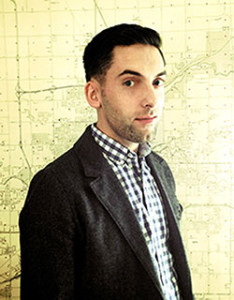 Andrew Morton: I was born in Derby, England, but moved to Michigan with my family when I was 12 years old. I was raised in a family full of musicians, but as a teenager I became more interested in theater. I studied theater as a undergrad and like most who follow that path, I originally thought I wanted to be an actor. However once I began to explore writing more I realized that was what I really wanted to do. I moved back to the UK in 2004, and then spent six years in London. During that time I was part of the Young Writers Program at the Royal Court Theatre, which I now consider to be one of the most valuable experiences in my artistic journey. I also got my Masters of Arts in Community Arts from Goldsmiths College, which was also incredibly influential on my practice as a theater maker. For a few years I ran several youth theater projects at the Blue Elephant Theatre in Camberwell, South London, and in 2010 I came back to Michigan. Since then I’ve been living in Flint, where I teach theater at UM-Flint and am Playwright-In-Residence at Flint Youth Theatre.
Andrew Morton: I was born in Derby, England, but moved to Michigan with my family when I was 12 years old. I was raised in a family full of musicians, but as a teenager I became more interested in theater. I studied theater as a undergrad and like most who follow that path, I originally thought I wanted to be an actor. However once I began to explore writing more I realized that was what I really wanted to do. I moved back to the UK in 2004, and then spent six years in London. During that time I was part of the Young Writers Program at the Royal Court Theatre, which I now consider to be one of the most valuable experiences in my artistic journey. I also got my Masters of Arts in Community Arts from Goldsmiths College, which was also incredibly influential on my practice as a theater maker. For a few years I ran several youth theater projects at the Blue Elephant Theatre in Camberwell, South London, and in 2010 I came back to Michigan. Since then I’ve been living in Flint, where I teach theater at UM-Flint and am Playwright-In-Residence at Flint Youth Theatre.
UMS: Can you tell us a little about your creative process? Where can we find you working on your art?
AM: I describe a lot of my work as “community-based”, so while occasionally I’ll be writing at home or at the Good Beans Cafe (hands down the best coffee shop in Flint), I also spend a lot of my time out and about talking and listening to people, or facilitating conversations that will inform the work I’m creating. I’m currently developing a new play for Flint Youth Theatre called The Most [Blank] City in America, which is inspired in part by the constant negative press that the city receives. As we want the play to represent a wide range of opinions on Flint and help challenge the dominant narrative of the city being a violent and depressing place, I’ve been working with a team of local artists to engage a wide range of community groups and individuals and listen to their stories about living in Flint. We’ve had conversations in music venues, schools, parks, and are just about to start a second round of these in the fall. The play will be produced at Flint Youth Theatre in April next year, so our challenge is to try and include as many stories and voices as we can in the final piece.
UMS: What inspires your art? Can you tell us about something you came across lately (writing, video, article, piece of art) that we should check out too?
AM: When I’m not working on a project I try to read plays and see live theater as much as I can, but I also enjoy a variety of art forms and try to experience different forms whenever I can. I love live music, and since I lived in London I’ve also become more appreciative of dance and physical theater. I’m always impressed by work that can tell a story without relying on words. Earlier this summer I saw one of the events by performance artist Nick Cave, who currently has an exhibition Here Hear at Cranbrook Museum. The event I saw was a performance at the Dequindre Cut in Detroit. It was a fantastic collaboration between the artist and several local groups, and I’m looking forward to his other performances later this year.
UMS: Are you engaged with the local arts community? Tell us about groups or events that we should know about.
AM: I love the arts community in Flint, and Flint as a place is a constant source of inspiration in my work. In addition to a amazing Cultural Center (with the Flint Institute of Arts, the Flint Institute of Music, the Whiting Auditorium, and more), Flint is home to many artists, performance groups and organizations who do some incredible work in the community and are getting national recognition. Sadly I think many people in Michigan aren’t aware of the rich artistic scene in Flint as we’re often overshadowed by places like Detroit and Grand Rapids, but I hope that’s starting to change. Flint is home to Raise it Up! Youth Arts & Awareness (who have an amazing youth poetry team), Tapology (a fantastic tap dance group), and The Flint Local 432 (an all-ages punk rock and multi-arts venue that is just about to celebrate it’s 30th birthday). Tunde Olaniran is a Flint-based musician who is blowing up right now, and is getting a lot of national press for his latest album, Transgressor. Of course, I have to mention my artistic home, Flint Youth Theatre. Unfortunately I think a lot of older people are put off by the word “youth” in our name, but the work we create is for audiences of all ages, and is consistently of a high professional quality. We produce both well-known plays and new works, and if you’ve never seen one of our productions you are missing out! Our next production is Little Women, which runs Oct 10-25.
UMS: Which performances are you most excited about this season and why?
AM: Honestly, I’m excited about them all. I saw Ivo van Hove’s A View from the Bridge at the Young Vic in London last year and it blew me away, so I’m excited to see what he does with Antigone. Young Jean Lee and Taylor Mac are two theater artists I’ve been following for a while now, but I’ve yet to see work by either of them. I think they are two of the most exciting voices in American Theater right now, so I’m thankful to UMS for bringing them to Michigan.
UMS: Anything else you’d like to say?
AM: I think I’ve said enough already… 🙂
Interested in more? Watch for more artist profiles on UMS Lobby throughout this week.
Dance is Alive and Well and Living in Detroit

Four dancers from Epiphany Dance perform in Harmonie Park during DDCF.
“If you’re going to do a triple, it’s got to be fast.” The spacious stage of the Detroit Music Hall stage looked skeletal as thirteen young women learned a complex piece of jazz choreography. Well, thirteen young women and one virtuosic young man, no more than eleven years old, whose pirouettes were right on par with the rest of the class. The sounds of Cher and Chaka Khan echoed off of the art deco ceiling of the theater before sinking into the rich red velvet of the seats. Dancers pulsated with energy, hitting each beat meticulously for just a moment before leaping into the next one.
My weekend at Detroit Dance City Festival was full of moments like that. The Festival, in its third year during Summer 2015, is the brainchild of ARTLAB J founder and dance innovator Joori Jung. Originally from Seoul, Korea, she moved to Detroit and, in two short years, took it upon herself to make Detroit more open to the international dance community. The weekend of the Detroit Dance City Festival was a conglomerate of art makers, performers, and the business-minded people making dance a sustainable practice. Some attendees did all three.
Mind you, I was very much a fly on the wall here. I Irish-danced as a girl, but I had hung up the hard shoes a while ago and was perfectly content with observing this perfectly postured world as it spun around me. Workshops like the one in the Music Hall were happening every day and ranged in focus from jazz to modern to West African. I watched many of them, but my personal favorite was taught by Beatrice Capote, a dancer in Camille A. Brown and Dancers company. Once the class began, the West African drum beat hardly ever stopped. Beatrice built small gesture upon gesture, introducing this unique style of dance to a large group of students foreign to the form, until the room was full of stomping feet and flailing arms, all somehow keeping time to the impossibly quick rhythm. One of the most important elements of this style, Beatrice stressed, was connection. West African dance is a form of communication, a way to celebrate the extraordinary elements of the ordinary day. Certainly this was true of the workshop. What began as a group of serious, focused young artists melted into a crowd of smiling young people, improvising, applauding, and laughing.
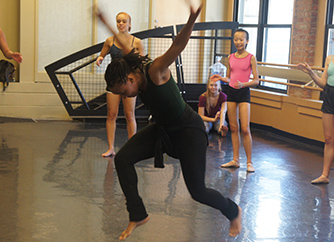
Beatrice Capote leads an improv session during her workshop.
That evening, Beatrice would perform a portion of Black Girl — A Linguistic Play with her fellow company members from Camille A. Brown and Dancers at the DDCF Gala, the cornerstone of the weekend. To begin the conversation on some of the elements of this work, she asked her workshop participants what they thought about when they heard the words “black girl.” There was an awkward silence, and I admit I was glad I didn’t have to come up with a response; there is no right answer to that question, but there are definitely wrong ones, and everyone treaded carefully with choice of words. Beatrice had obviously asked this question before and was familiar with this reaction. In fact, she said that it was this tension surrounding the concept of “black girl” identity that prompted Camille A. Brown and her dancers to create this work. Using what Beatrice referred to as “vernacular dance,” the company has referenced playground interactions, sibling bickering, handshakes, and pop culture (if you look closely you can spot Beyoncé’s infamous Single Ladies chug) to elevate the experience of young black women. The performance was moving, and the piece in its final state, coming to UMS in February, will not be one to miss.
The weekend was full of performances. I spent my late afternoons in the charming Harmonie Park across from the bustling Carr Center watching local dance troupes perform in beautiful sunshine. One group of four young girls from Epiphany Dance, a Detroit-based company, stood out in particular. Clad in bright yellows and greens, they glided across the stage in beautifully executed choreography. As I watched I couldn’t help but connect their passion with what is at the heart of Camille A. Brown’s work; these girls, sharing what they love without reserve or restraint, seemed to me to encompass what Camille might seek to capture in her art. Many of these outdoor performances felt just as joyful. I loved the way the brief season of Michigan warmth was animated through hip-hop, lyrical, rhythmic gymnastics, even Polynesian dance.
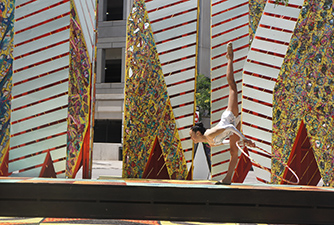
An exciting rhythmic gymnastic performance in Harmonie Park.
In the evenings, the art makers shined at the Choreographer Showcases. The first two nights of the Festival featured over twenty pieces from choreographers from across the country. I, like many, am a bit of a novice to the current trends in dance, and was pleasantly surprised to discover that dance is capable of much more than I initially assumed. I learned that, contrary to popular belief, dance does not need music. I saw multiple pieces in partial or total silence, pieces that kept me completely engaged. Dance can also use video, voice, and live music to elevate movement. One of my favorites used traditional mime techniques melded to modern hip hop to create a metaphor for immigrating to the states. I was mesmerized. As one participant told me, “The modern movement blew open the possibilities of dance, and we’ve been trying to figure out to do with it ever since.”
While performance was certainly the focus of the Festival, the weekend had an undercurrent of stimulating conversations about sustaining dance in Detroit and strengthening the international dance community. Through a series of panel discussions, I learned about the numerous organizations in Southeast Michigan who are dedicated to helping dance and those who create it thrive. Shivangee Pandya represented Creative Many, a group that advocates for the development of professional artists in Michigan. They provide legal aid, educate on the fundamentals of becoming a non-profit, and assist in contract work. They recognize that being a professional artist means running a business, and their dedication to the establishment of solid foundations for these artists shows a profound respect the dignity of creative work. I had the chance to chat with Lynne Friman of Culturesource and IXITI, a website that posts any and all creative performances and events happening in and around Detroit. With a shock of purple and blue hair and a big smile, she was able to list at least three people in the Detroit arts scene that you must know, all within the first five minutes of my chatting with her. She, and many others in attendance, are living advocates for the growing number of dance, theater, and music artists in the area, and they’re dying to tell you about it.
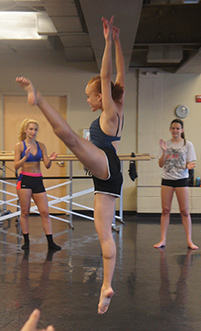
A dancer leaps during Beatrice’s workshop.
Equal parts celebration and exploration, the Detroit Dance City Festival never shied away from asking what dance is capable of. It wondered if it needed music, how it could be filmed, what props it could use, and who had access to it. The result was a real sense of community, a group of people who are willing to decide where dance can go from here. They will create the work, fund it, and find the audience, and they’ll enjoy the process just as much as the final product. It was exciting to be in on the secret that Detroit is rising fast on the global dance scale. Something tells me it won’t stay a secret for long.
UMS Night School: Curious About Dance – Session 5 Recap
Editor’s note: This post is a part of a series by U-M student and UMS intern Hillary Kooistra, who’s covering our free UMS Night School: Curious About Dance workshop series.
Moving Forward
This past Monday evening, our last Night School session of the year, we celebrated an enriching, inspiring, and fun-filled five weeks by reflecting on our past lessons and looking toward future engagement opportunities. The time has flown and I cannot believe how quickly Graduation Day arrived, but before we could break out the Pomp and Circumstance, we had a stunning weekend of dance to unpack! We began our session with an exercise and discussion around this past weekend’s Abraham.In.Motion performances, then transitioned to wrapping up the entire semester. Over the course of the evening, we moved from speaking specifically about one company’s work to thinking in general terms about dance we’ve seen this season and will see in the future; once again proving that though there are infinite ways to approach movement exploration and discussion, similar concepts appear and circulate among these seemingly different dance works.
We began our session a bit differently on Monday night. Instead of sharing and repeating gestures, laughing at one another’s creativity or manipulating the movement we perceived; we stood in our circle with closed eyes. Checking in with ourselves and becoming comfortable in the space, we freed our bodies and minds to think about this past weekend’s double bill. When we opened our eyes, we assumed a pose that reflected a particular moment of resonance from either Friday or Saturday night’s performance. Instead of teaching and repeating one another’s poses, we split into groups and created tableaus: placing our individual gestures into a larger, multi-layered, ensemble-based story.
Left: Group 1’s tableau: “Evolution” aka “Static and Moving” aka “The Descent of Man (and Rise of Woman” aka “Past, Present, and Future” Right: Group 2 and Group 3’s tableau: “Gather and Cast Away” aka “Fronts and Backs” aka “Claws”
This exercise proved to be just as much about those observing as it was about those posing the tableaus. As we examined one another’s work, we shared our interpretations by thinking of possible captions or titles for each image. We discovered numerous ways to view and manipulate the tableaus–experimenting with movement and stillness, placing together two figures that were created separately to create one large image, crafting a sound score to accompany the posing bodies–and witnessed the infinite layers of perception we craft as we discover the infinite ways to shape a single idea. (Most importantly, we discovered that Jim has quite a fierce relevé.)
Group 3’s moving tableau: “Motion and Stillness” aka “Offering aka “Centrifugal People” aka “Soup Pot” (…? Thanks for that one, Jim. Go practice your relevé.)
The discussion of The Watershed and When the Wolves Came In that followed our art gallery visit demonstrated how Kyle, as a choreographer, takes a similar approach to develop complexities within his work. We questioned the motion of stillness, layers of rhythm, and pliancy of movement in each work, and recognized the historical and present-day contexts accompanying these more conceptual ideas. Though we might not be able to pinpoint the exact starting point of each specific work, we can see there are multiple ways to enter and navigate his dances, just as there were for the tableaus we created.
During our final post-performance group discussion of the semester, I couldn’t help but smile as I recognized how much we have grown over the past five weeks. With over a month of dance exploration under our belts, we can offer intelligent, informed, and inquisitive thoughts about any movement exercise or performance reflection we engage in. We have also developed a rich collections of dance experiences to pull from as we allow past dances we saw or lessons we learned to inform our perceptions of new works. And from learning labanotation to telling secrets through gesture, from watching a pas de deux of plastic bags to contemplating the historical imagery within a dance work that explores the enigma of freedom, we have certainly experienced more than a taste of everything offered, not only in this diverse UMS dance season but in the dance world as a whole.
We took all of these thoughts with us as we transitioned to the “graduation” component of Monday’s Night School session. The celebration began with some refreshments and prizes! A special congratulations to Fred, Harvey, Rebecca, Carol Rose, and Lisa, who were recognized for their perfect attendance, and to Susan for winning the Door Prize Raffle. Enjoy some pizza for all of us! Or better yet, take us with you! Though the cupcakes were delicious as always, I think the real treat was the peek inside the next UMS dance season, which looks absolutely incredible. The companies that visit us will certainly feed our growing curiosity and reveal even more ways to think about movement. There will be the same engagement opportunities that we know and love: You Can Dance Classes, Post-show Q&As (led by Clare, no doubt), and Sunday post-performance Brunch Tune-Ins. Next year’s Night School will focus on the UMS Renegade Series, which you should definitely attend if you want to know more about the outside-the-box, forward-moving performances that UMS presents.
Congrats, Grads!
So get ready to buy your tickets, which will go on sale after the official UMS Season Launch party, taking place on April 24th (right before the opening performance of Lyon Opera Ballet’s Cinderella) on the fourth floor of Rackham. It’s free and open to the public, so grab a friend, head to Rackham, and then go enjoy our last dance performance of the season! Though we won’t be convening in the Alumni Center to discuss, hopefully you will be able to share your impressions over coffee, dinner, or gestural movement after the show.
And that’s all, folks! Now that this semester of Night School is complete, please don’t be a stranger–to UMS, the Department of Dance, or movement in general (definitely not to movement in general…moving is important). There are plenty of opportunities to watch and engage in performance left this year: in addition to the UMS performance of Lyon Opera Ballet, the Department of Dance has a number of upcoming shows (including my senior BFA concert and Charles’s graduate choreography work!), that we would love for you to attend. In the meantime, tell your friends about all of the wonderful dance you’ve experienced, and hopefully we will see you in the Alumni Center next season! Thank you all for your wonderful questions, insights, and energy over the past five weeks!
Left: Much love from your Department of Dance Night School reps! Right: Our crazy, kooky, intelligent band of Night School folks. Performing gestures, of course.
UMS Night School: Curious About Dance – Session 4 Recap
Editor’s note: This post is a part of a series of by U-M student and UMS intern Hillary Kooistra, who’s covering our free UMS Night School: Curious About Dance workshop series.
Anything You Do Will Be Perfect
Welcome back, Night Schoolers! I hope everyone enjoyed their time off! The sun has been shining all week and it was certainly shining in the Alumni Center on Monday night. We were joined by Kyle Abraham, Founder/Artistic Director of Abraham.In.Motion (AIM): the company that will grace the Power Center stage this coming Friday and Saturday. Also with us was Matthew Baker, AIM choreographic associate/dancer, graduate of Western Michigan University, and Ann Arbor native. These two incredible artists invited us into the world of Abraham.In.Motion by demonstrating and talking about the company’s work, as well as allowing us to embody a bit of their choreographic process. Kyle, a MacArthur Award recipient and fascinating thinker/speaker/mover, confirmed an idea we have returned to each Night School session: dance is a thoughtful, collaborative and process-driven art form.
Kyle kicked off our session by showing us video clips of some of his work: Live! The Realest MC, Pavement, and the two works that his company will perform on Friday and Saturday: The Watershed and When the Wolves Came In. As we watched these intersections between stunning movement and innovative stage design, Kyle described the thought, research and collaboration behind the dances. We were then able to make informed, conceptual observations about each work while enjoying some incredible aesthetics. No wonder this man won a genius grant!
Kyle Abraham talks about his process before showing us clips of some of his dances.
After giving us a chance to see and hear about his dances, Kyle introduced us to the way he works with his company and let us experience his choreographic process with our own bodies. He led us through a few creative activities he uses to establish movement and choreography in collaboration with his dancers. Kyle is not one to simply enter a rehearsal with set material for his company to learn and replicate; his process-driven approach to choreography pays careful attention to the potential contributions of each individual body and mind in the room.
Kyle explains some of the intentions behind his process to a curious Night School cohort.
With these ideas in mind, we plunged into some AIM-motivated movement invention and exploration. First, we learned and practiced a simple arm gesture phrase (from The Quiet Dance, another work in his company’s repertoire).We executed this upper body sequence as we learned it, while letting our legs do whatever they wanted. We also explored a way to compose our own phrases by responding to “Action Words.” As Kyle (and fellow Night School Student Fred) prompted us to slice, jump, slide, squish, wiggle, and dive, we travelled across the room with our own sequences of movements and rhythms.
Night School students experience Kyle’s choreographic process: creating our own leg movements to accompany a set of arm gestures and travelling across the room in response to Action Words.
Kyle explained that the movement he and his dancers generate out of such tasks often becomes the starting point for phrases in his repertory works. In a third exercise dubbed “Catch What You Can,” he and Matthew demonstrated how one seed idea can blossom into a longer, lasting sequence. Kyle grooved to some music while Matthew followed behind him, trying to grasp as much movement as he could. Then Kyle instructed Matthew with prompts such as “left arm and leg chug back,” and “figure eight to the right,” as well as names of moves that seemed to have a significance within the company, such as “Classic.” Regardless of the prompt’s origin, Matthew remained on the same page as Kyle the entire time, and breezed about the floor as he constructed his phrase. The result was amazing. From Kyle’s few moments of visual and verbal cues, Matthew danced an entire phrase of movement without stopping to think once: leaving us asking, “Did that just happen?”
Abraham.In.Motion dancer Matthew Baker develops a sequence of movement by “catching what he can” of Kyle’s visual and verbal cues
Once we picked our jaws off the ground and Matthew got a chance to catch his breath, we sat back down for a conversation with the two artists. Kyle provided generous answers to our questions about his company and process, sharing insights about the shifting roles of dancers and choreographers, the value of time in choreographic development and honesty in performance, and the approach to working with new bodies while creating work on others. I must be getting early onset nostalgia as we approach our final Night School next week, because I could not help but recall all the lessons we’ve learned this semester as I heard Kyle speak about his work. Remember the exercise we did with Martine a couple of weeks back, where we had to remember our partner’s gestures as they told us “something nobody knew”? I thought of that session throughout Kyle’s “Catch What You Can.” How Charles helped us alter gestures so they would fit the two-dimensionality required by labanotation? Very similar to how Kyle revealed he will develop a gesture until it has traces of its origin but breathes a new life.
If there’s one thing I think we’ve all learned through Night School this year, it’s that there are many, many entryways into making, viewing, and discussing dance. We’ve had the privilege of unfolding these multiple layers throughout the weeks: questioning why plastic bags float in the air, how people walk on walls, or where Kyle Abraham finds his musical inspiration. But more time for reflection next week. This week, we have a marathon of events related to Kyle’s residency to look forward to! Remember, Friday and Saturday will showcase two different programs, so why not buy two sets of tickets and camp out at the Power Center this weekend? You can even stay an extra night and be fed bagels on Sunday at the first ever UMS Brunch Download Conversation. Hope to see everyone this weekend, and at our LAST session/graduation next Monday night! In addition to thinking about the UMS dance season still to come, we will be celebrating with our Adventure Card raffle drawing, Perfect Attendance Awards, and of course, some food and drinks. So don’t miss out! No cap and gown necessary, just your presence and energy.
Upcoming Events:
Abraham.In.Motion Performances, Mar. 13-14, 8pm, Power Center (TICKET REQUIRED)
Related:
Mar. 13: Opening Night Q&A: Abraham.In.Motion, Power Center, post-performance (TICKET REQUIRED)
Mar. 14: You Can Dance: Abraham.In.Motion, Ann Arbor YMCA, 1:30-3pm (FREE – SIGN-UP REQUIRED, BEGINS AT 12:45PM, FIRST COME FIRST SERVE)
Mar. 14: Closing Night Q&A: Abraham.In.Motion, Power Center, post-performance (TICKET REQUIRED)
Mar. 15: Brunch Download with Kyle Abraham, U-M Alumni Center, 11am (FREE)
Session 4 Resources:
Kyle Abraham/Abraham.In.Motion, Live! The Realest MC Promotional Video
Kyle Abraham/Abraham.In.Motion, Pavement Promotional Video
Kyle Abraham/Abraham.In.Motion, The Gettin’ Promotional Video
UMS Night School: Curious About Dance – Session 3 Recap
Editor’s note: This post is a part of a series of by U-M student and UMS intern Hillary Kooistra, who’s covering our free UMS Night School: Curious About Dance workshop series.
Presenting: The Trisha Brownie Dance Company
After a whirlwind week of dance, we had plenty to discuss during our latest Night School session. We had two special treats on Monday evening: the first was the opportunity to hear Clare Croft, our trusty Night School leader, speak with Jim Leija, UMS Director of Education & Community Engagement, about her new book, Dancers as Diplomats: American Choreography in Cultural Exchange. The second treat, of course, came in the form of cupcakes, which we enjoyed after the discussion. Before we crossed overseas to learn about dance’s contribution to cultural diplomacy, we focused on some exciting moments in American dance, with a reflection on last week’s performances of Confetti Sunrise and the Trisha Brown Dance Company.
Professor Amy Chavasse invites us into the world of Trisha Brown
We were joined on Monday evening by U-M Associate Professor of Dance Amy Chavasse, who guided us through some physicality unique to Trisha Brown. Trisha emphasized the idea of “pure movement” in her work: movement based on mechanical body actions such as bending, straightening, or rotating: stripped of any metaphor or connotation. Trisha built on this essential, pure movement to create the much of the porous, fluid, and surprising choreography we saw this weekend. Amy helped us understand these sensations by inviting us to create and erase edges; set up expectations only to veer in a different direction; and produce gestures that hold specific meaning to us, but appear abstract to the outside eye.
Exploring Trisha Brown’s notion of “pure movement”
I think it is safe to say that after this movement workshop, we are all ready to fly to New York and dance for Trisha Brown. Alas, we had to save our debut as the Trisha Brownie Dance Company (thank you, Charles, for coining the name!) for another day, because there was too much to talk about here in Ann Arbor! We began a rich conversation about this weekend’s performance, acknowledging the elements we saw on the program (costumes, lights, set pieces) as entry points into the dances’ worlds. We also made a nice connection between Trisha Brown, Confetti Sunrise, and the workshop that Anna Martine Whitehead led for us during our last Night School session: thinking about gesture as a mechanism for developing movement and meaning. As we discussed the moments of delight, curiosity, and even discomfort we found in all of the works we watched over the week, we asked ourselves: What are we supposed to care about when watching dance? What do we bring to each performance that may influence our interpretations? How does time collapse and expand as we view performance that holds its own chronology in dance history, as well as in our own experiences?
Clare and Jim discuss Dancers as Diplomats: American Choreography in Cultural Exchange
Each week, I am excited by the ways our interpretations of specific performance works lead to larger discussions about what it means to view and discuss dance. Though we usually approach this broader conversation through performance analysis, this week we were lucky enough to explore ideas behind dance scholarship through Clare’s research on diplomacy in American dance. Her book, which you can buy from UMS for only $20 (excuse my shameless plug!), chronicles dancers’ perspectives of government-sponsored international tours by American dance companies during the early decades of the Cold War and twenty-first century. During the last half of Night School, Clare and Jim sat down to talk about Dancers as Diplomats, divulge some details behind the stories in the book, and answer our questions about the topic.
U-M Department of Dance faculty and students smile with Clare after a conversation about Dancers as Diplomats
Night School students Rebecca and Sam (photo on left) and Ed and Harvey posing with cupcakes and newly purchased copies of Clare’s book!
We have the perfect opportunity to crack this book open, as next week we are off for mid-winter (I just can’t bring myself to say spring) break. I’ll be in Las Vegas, and I have to say I’m more excited about my Cirque du Soleil tickets than I am about the casinos. I guess you can take the girl out of Night School but…
Whether you are travelling or staying in Michigan, I hope you find well-deserved downtime, and perhaps some opportunities to watch, discuss, or even practice dance! We return to the Alumni Center on Monday, March 9th and will be joined by the fantastic Kyle Abraham, whose company Abraham.In.Motion performs at the Power Center that weekend. As a hot, rising choreographer in today’s contemporary dance field, Kyle’s work will provide us with a new lens through which we view performance; it will be a real treat (unfortunately this time without the cupcakes) to have him with us for a session. See you all in two weeks!
Can’t wait to read my copy of Dancers as Diplomats!
Upcoming Events:
Hou Ying and Peng Zheng Dance Performance, Feb. 24, 7pm, U-M Keene Theater (FREE)
Session 3 Resources and Readings:
Resident Update: Artist Carolyn Reed Barritt on Compagnie Non Nova
Painter Carolyn Reed Barritt is a UMS Artist in Residence this season. We’ve asked five artists from across disciplines to take “residence” at our performances and to share the work these performances inspire.
Carolyn attended Compagnie Non Nova‘s performance of Afternoon of a Foehn this past weekend at Skyline High School’s black box theatre. She shares her thoughts on the performance:
“I didn’t think I could be so enraptured by ordinary plastic bags…The performance is mastered chaos — each fan controlled to create an airflow which allows the bag puppets to twirl, float and wrestle with each other and their creator in a confined space. Sometimes the puppets skate together along the floor; sometimes it seems as though they are tying to escape by floating up to the ceiling. Sometimes they seem to attack each other. Their creator moves with them, allowing them to dance and fight until they turn on him, using the wind that animates them to envelope and smother him with their bodies, making him so angry he destroys them all. The audio track ebbs and flows from sublime to sinister, the bag puppets go from charming to vindictive, the single, silent actor, ghost-like and imperious — all this in a home-made wind vortex.
If you’re lucky enough to be in Ann Arbor Michigan right now, there are more shows this coming weekend (February 19 – 21, 2015). Otherwise I hope this show comes to you someday!”
Read the full post on Carolyn’s blog
Interested in learning more? Read our interview with Carolyn.
UMS Night School: Curious About Dance – Session 2 Recap
Editor’s note: This post is a part of a series of by U-M student and UMS intern Hillary Kooistra, who’s covering our free UMS Night School: Curious About Dance workshop series.
It’s Just So…French
We might be facing sub-zero temperatures outside this week, but things were definitely heating up in the U-M Alumni Center on Monday night. We began our second Night School session with a stimulating conversation about Compagnie Non Nova’s Afternoon of a Foehn, then launched into a movement workshop led by newly Chicago-based solo contemporary artist Anna Martine Whitehead. Gestures played a key role in Monday’s session; in both our post-show reflection and Martine’s movement workshop, we found ways to make meaning through the creation, manipulation, and reimagination of repeated motions.
To begin the session, Clare reintroduced our Night School ritual: saying our names while performing a gesture. This time, as a way to kick off the conversation about Compagnie Non Nova, we recalled and produced gestures from the performance. Afternoon of a Foehn runs through next weekend, so those of us who have not yet seen it were instructed to amplify someone else’s gesture. The result? A highly creative game of movement telephone that had us moving in, out, and through our circle in response to one another’s memories of the performance.
We then shared the significance of the gestures we picked, and identified themes and concepts that stuck with us as we watched the performance. What makes a strong visual in performance? How do the rules established in performance alter our expectations of what is to come? How can the performance space change throughout the narrative, and how can it change us? These are only some of the questions that came up as we dissected our own interpretations of the captivating piece of experimental theatre (/dance/ballet/performance art…as we discussed, the category in which it falls is really up to interpretation).
We also landed on a discussion about the conventions of French performance, and how American audiences identify the work produced by European companies as well…European. The hierarchies of performers, sense of pride in claiming a space, and abstraction of narrative are some of the aspects we landed on as, to quote Clare, “just so…French.” For those who plan to head to Skyline High School this weekend, I’d be curious to hear if these concepts stick out to you as you watch the performance.
Warming up for a movement workshop by exploring negative space and interacting with others.
Our discussion of the many ways to approach and interpret Afternoon of a Foehn served as a perfect segway to Martine’s workshop, which centered around the choreographic approach of rethinking movement. She associated this process with Queer Dance, which offers alternative ways to think about gender and sexuality, critique the normal, and imagine other ways to be in the world. Martine will demonstrate this mode of thinking in this week’s performance of Confetti Sunrise, which features the work of Martine and four other queer artists. The workshop served to prepare us for this show, as well as for this weekend’s performance by the Trisha Brown Dance Company.
Throughout the half hour we spent stretching, speaking, moving, and listening, Martine invited us to think: How can gesture make meaning? How can we embellish it, and do it so much that it creates own score? She invited us to act on our instinct, focusing on the concepts of compulsion and desire.
Indulging in stretches during Anna Martine Whitehead’s movement session!
We ended the session in conversation with a partner, during which words were not the primary conversational agents. Responding to the prompt “tell me something that nobody knows,” we performed for our partners a series of gestures that they recalled and repeated back to us. We then manipulated the gestures that we grabbed from our partners (embellished, amplified, repeated, took to a different level…) and created a repeatable sequence–known in dance as a phrase. The exercise encouraged us to think about movement, maybe first as a substitute for words, but then as its own entity whose meaning might veer away from the choreographer’s original narrative.
My fantastic partner, Howard, tells me something that nobody knows using only gestures.
Howard recalls the gestures I conveyed to tell him something that nobody knows.
I was happy to think about this exercise not only from a Queer Dance perspective, but within the context of Trisha Brown. I interned for the company this past summer through UMS’s 21st Century Artist Internship Program, and I was lucky enough to take composition/improvisation classes with Associate Artistic Director Diane Madden while I was there. In class, Diane introduced to me Trisha’s choreographic method of “throwing and catching” movement: Trisha often performed gestures or longer series of movement for her dancers, then asked them to repeat them back to her without ruminating on what they saw. The dancers’ interpretations of her movements ultimately inspired much of her choreography. As I explored this process over the summer, I developed an awareness of how I interpreted movement and how my own movement resonated with others. I was excited to return to this way of working in Night School, and to draw ties between Trisha’s historic work and the innovative contemporary work of Queer Dance artists.
Silent conversations with partners–using gestures to convey meaning.
Speaking of Trisha Brown, we have quite the marathon of dance ahead of us in Ann Arbor this week! Compagnie Non Nova, Confetti Sunrise, Trisha Brown, Dance on Camera…we can have a quadruple bill if we really want to! Remember, if you go to more than one performance this weekend, you are eligible for double stars on your UMS Card. More stars, more dance, more fun.
Next Monday, we will be joined by U-M Associate Professor of Dance Amy Chavasse for our discussion of Confetti Sunrise and Trisha Brown. Then we get to raise a cupcake to Clare in celebration of her new book! She and Jim will be in conversation about Dancers as Diplomats: American Choreography in Cultural Exchange for the latter half of our session, so come hungry for treats and lots of dance talk! (Photocopies of Clare’s first two chapters can be found in our Night School folders, if anyone wants to complete a little pre-reading.)
Events This Weekend:
- Compagnie Non Nova, Afternoon of a Foehn, Feb. 14-21, various times, Skyline High School. TICKET REQUIRED
- Confetti Sunrise, Feb. 18-19, 7:30pm, U-M Duderstadt Center, Video Studio (FREE BUT LIMITED SEATING, FIRST COME FIRST SERVE)
- Dance on Camera Festival, Feb. 21-22, 6pm, U-M Museum of Art, FREE
- Trisha Brown Dance Company Performances, Feb. 21-22, 8pm, Power Center. TICKET REQUIRED
- Related Events:
- Feb. 21: You Can Dance: Trisha Brown Dance Company, Ann Arbor YMCA, 10:45am-12:15pm (SIGN-UP REQUIRED, BEGINS AT 10AM, FIRST COME FIRST SERVE)
- Feb. 21: Tune In: Trisha Brown Dance Company, Power Center Lobby, 7:30-7:45pm (TICKET REQUIRED)
- Feb 21: Opening Night Q&A: Trisha Brown Dance Company, Power Center, post-performance (TICKET REQUIRED)
- Related Events:
Session 2 Resources and Readings:
Dancers as Diplomats by Clare Croft
Introduction
Chapter 2
UMS Night School: Curious About Dance – Session 1 Recap
Editor’s note: This post is a part of a series by U-M student and UMS intern Hillary Kooistra, who’s covering our free UMS Night School: Curious About Dance workshop series.
Not New, But In a New Way
If one thing was made clear from Monday’s first session of Night School (besides the fact that Clare Croft calls “intermission” “half time” like in basketball games), it’s that there are tons of awesome dance performances happening in Ann Arbor this winter. Between intimate experimental works, large-scale productions, films screenings, and more, we’ll have plenty to discuss in our Night School sessions each week. As a senior Dance Major at U-M and an avid fan of performances that push the boundaries of how we interpret movement and storytelling, I am definitely looking forward to unfolding this Night School series with a new cohort of dance enthusiasts. I’ve only experienced an hour and a half of Night School so far, but I can tell I’m going to have a great time, especially knowing that each session will be led by two wonderful members of the U-M Department of Dance: Professor Clare Croft and first-year MFA candidate Charles Gushue.
Curious about dance, and all ready for Night School!
We began tonight’s session with a crash course in watching and writing about dance. Clare, a longtime dance critic and writer (who just celebrated the publication of her new book!) showed us some examples of writing that successfully paints a picture of movement on stage. We then engaged in our own writing exercise: we watched four fellow classmates embody aliens exploring the planet and came up with our own descriptive sentences based on the detailed notes we took during their performance.
We observed these four Night School participants and came up with sentences to describe their movement and interactions with the space. It definitely wasn’t too difficult to come up with colorful metaphors, given these vivid characters and images!
Writing about dance begins with observation, and requires awareness and acknowledgement of what it is that we notice. As we observed these “tasty little animals moving through the jungle” (as described by one Night School student), Clare prompted us to take note of details such as how the performers interacted with objects in the space, how they directed their focus, which body parts they maneuvered.
The three major elements of successful dance writing.
After we landed on some descriptions that envied the writing of Deborah Jowitt, Charles launched into a set of activities that prepared us for this weekend’s performance: Afternoon of a Foehn, presented by Compagnie Non Nova. This experimental work is set to Claude Debussy’s Prelude to the Afternoon of a Faun, which also serves as the musical score for the Vaslav Nijinsky ballet L’après-midi d’un faune (The Afternoon of a Faun). Charles shared his experiences dancing Nijinsky’s Faun, and introduced labanotation as a way of seeing how the ballet choreographer recorded his movement on paper.
Night School students Harvey and Linda try out one another’s movement via labanotation.
We experimented (and jovially struggled!) with our own versions of labanotation, then got a taste of Compagnie Non Nova’s interpretation of the Debussy score through plastic bags, which serve as the main playing characters for the production. As we tossed these bags around the circle like a group of slap happy children on the playground, Charles invited us to call out words that described our actions–returning to Clare’s earlier point about how we can use words to describe the movement and interactions we notice. This is what I love about the versatility of the Night School series: in one session, we can regard the movement of the Trisha Brown Dance Company and flitting plastic bags as equally legitimate agents for describing and discussing dance.
Having fun exploring the motions of plastic bags in preparation for Compagnie Non Nova!
Next week, we’ll kick things off with a reflection of Compagnie Non Nova, then begin to prepare for the next set of performances. We will be joined by U-M Associate Professor of Dance Amy Chavasse, who will introduce us to work of the Trisha Brown Dance Company (performances at Power Center Saturday, 2/21 and Sunday, 2/22); and solo contemporary artist and performer Anna Martine Whitehead, who will appear in the U-M Department of Dance performance of Confetti Sunrise (Wednesday, 2/18 and Thursday, 2/19 at the U-M Duderstadt Center Video Studio). These productions, Afternoon of a Foehn included, will each offer us new ideas about how to view and interpret performance, and I can’t wait to see what discussions surface in next week’s session!
Performances this weekend: Compagnie Non Nova, Afternoon of a Foehn, Feb. 14-21, various times, Skyline High School. TICKET REQUIRED.
Session 1 Resources and Readings:
Dancers as Diplomats by Clare Croft
Introduction
Chapter 2
Resident Update: Writer Robert James Russell
Writer Robert James Russell is a UMS Artist in Residence this season. We’ve asked five artists from across disciplines to take “residence” at our performances and to share the work these performances inspire. Robert shares his experiences on dance, music, and his new novel below:
“When I applied for the UMS Artists-in-Residency program, my goal was to see performances and use that inspiration to craft a new novel. I’m beyond thrilled at the chance to experience wonderful performances and explore the role of music and dance in my work—both of which have always been crucial to my mental health, and to my ability to immerse myself in a project.
So far, I’ve seen the following UMS performances, all radically different from one another—and each has inspired me in vastly different ways:
- Ryoji Ikeda (superposition)
- Mariinsky Orchestra
- Compagnie Marie Chouinard
- eighth blackbird
See, this isn’t just writing a novel, coming up with a story and characters, but in this instance I am creating an entirely new place: a fictional island in Lake Superior, documenting the entire history of the island, of the people that lived (and, in the present of my novel, still live) there. Typically when I write I find some style of music that works for that story and I listen to the same record(s) over and over as I write, never growing tire of the repetition. In this instance, though, since it’s not just story, but history…and this immersion in different types of performances has been utterly liberating:
- superposition taught me, even through the wondrous noise, about the use of silence in my work.
- The Mariinsky Orchestra inspired me to embrace more bombastic/dramatic sections of the story.
- Watching the Compagnie Marie Chouinard showed me how to re-think interactions of characters, how they meet in the story, but also how these characters interact with the island itself.
- eighth blackbird encouraged me to embrace the unexpected—to travel different routes in the storytelling, in the creation of the island’s history, of its inhabitants, and to avoid the predictable…to really dig deep and do something unique.
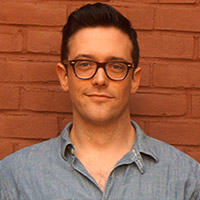 Each of these performances has taught me re-think what I know about art and inspiration, and they are with me every day when I write. In addition to a seemingly never-ending list of books I flip through daily—various back-issues of National Geographic featuring articles about Isle Royale (used as inspiration); a 1937 manual called Wolf and Coyote Trapping; the unbelievably inspiring/gorgeous Atlas of Remote Islands by Judith Schalansky; others—I am constantly harkening back to each performance, remembering them, and making sure that they are not forgotten. And I am reminded with every word I put down how astonishing and remarkable the performing arts are…how important they are to the production of any art.”
Each of these performances has taught me re-think what I know about art and inspiration, and they are with me every day when I write. In addition to a seemingly never-ending list of books I flip through daily—various back-issues of National Geographic featuring articles about Isle Royale (used as inspiration); a 1937 manual called Wolf and Coyote Trapping; the unbelievably inspiring/gorgeous Atlas of Remote Islands by Judith Schalansky; others—I am constantly harkening back to each performance, remembering them, and making sure that they are not forgotten. And I am reminded with every word I put down how astonishing and remarkable the performing arts are…how important they are to the production of any art.”
——
Robert James Russell is the author of two upcoming books: the collection Don’t Ask Me to Spell It Out (WhiskeyPaper Press, 2015) and the novel Mesilla (Dock Street Press, 2015). His first novel, Sea of Trees, was published in 2012. He is the founding editor of the literary journals Midwestern Gothic and CHEAP POP. You can find him online at robertjamesrussell.com and @robhollywood.”
Interested in learning more? Read our interview with Robert.
Resident Update: Painter Carolyn Reed Barritt on Compagnie Marie Chouinard + Mariinsky Orchestra
Painter Carolyn Reed Barritt is a UMS Artist in Residence this season. We’ve asked five artists from across disciplines to take “residence” at our performances and to share the work these performances inspire.
Carolyn attended Compagnie Marie Chouinard on January 23rd, and Mariinsky Orchestra on January 25th, 2015. She shares her thoughts on both performances:
“M
arie Chouinard’s Gymnopedies begins languidly, with the dancers emerging nymph-like and naked from canvas pods, then morphs into a seemingly non-stop riot of movement and role playing that was sometimes so sexy it was almost uncomfortable and sometimes so childishly silly that the audience didn’t quite know whether or not to laugh. The Henri Michaux piece brought movement up to another hyper level and was reminiscent of a dance contest gone too far. The dancers, mimicking the projected ink blots of Michaux’s Mouvements, expressed the drawings in broken, jagged lines, with an awkward jerkiness that was softened with a fluid, serpentine beauty.”
On Mariinksy:
“Before entering the hall for Mariinsky, I was given a flyer by a person protesting the orchestra. Last weekend I read the New York Times’ interview with Gergiev. I know a little about the situation in Ukraine, but don’t know as much as I should. Reading neither the flyer or the Times interview really enlightened me as to Gergiev’s personal views or the views of anyone in the orchestra. But what I have heard and read about Ukraine was in my mind at the concert and I’m sure it tainted my experience that afternoon.”
Read the full post on Carolyn’s blog
Interested in learning more? Read our interview with Carolyn.
Student Spotlight: On the Road with Trisha Brown
Editor’s note: During the summer of 2014, UMS launched a new 21st Century Artist Internship program. Four students interned for a minimum of five weeks with a dance, theater, or music ensemble part of our 2014-2015 season. Hillary Kooistra is one of these students. She spent the summer in New York and on the road with the Trisha Brown Dance Company.
Below she recounts her travels with the company. The Trisha Brown Dance Company will perform Proscenium Works, 1979-2011 at the Power Center on February 21-22.
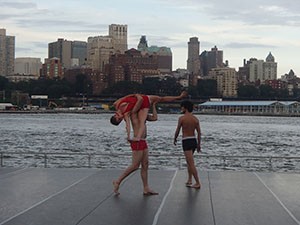
TBDC Dancers Tara Lorenzen, Nick Strafaccia, and Olsi Gjeci perform “I’m going to toss my arms — if you catch them they’re yours” on Pier 15 at the South Street Seaport in NYC.
As an embedded intern with the Trisha Brown Dance Company (TBDC), I worked alongside TBDC administrators and artistic directors, observed the company in rehearsals, befriended the dancers, learned repertory and improvisation/ composition techniques from TBDC alumni, and watched many, many performances. During my internship, I accompanied the dancers and TBDC artistic staff on two trips. This gave me a taste of life on the road for a dancer in an international touring company and allowed me to develop a deep understanding of the diverse performance programs that the Trisha Brown Dance Company presents.
The first stop on my personal tour with TBDC was Annandale-on-Hudson, New York, where the company was invited to perform selections from its Proscenium Works, 1979-2011 tour (the final tour of Trisha’s repertory works specifically choreographed for the stage, coming to Ann Arbor in February). After a NYC performance of “I’m going to toss my arms, if you catch them they’re yours” (fondly referred to by the company as “Toss”), I joined the company in a 15-passenger van headed toward Bard College. Though I was new to the touring artist lifestyle, I quickly learned that this pace is typical for the dancers. In one day, they danced on a pier overlooking the East River, drove upstate from New York City, and prepared for the next round of performances!
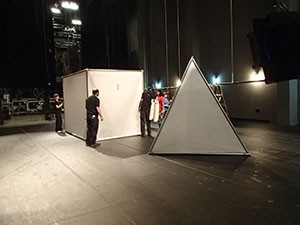
Load-in of Robert Rauschenberg’s set piece for “Set and Reset” prior to the company’s Bard SummerScape performance.
We arrived at Bard late that night. Throughout the weekend, I found myself enchanted by little details of tour life, as mundane as they may seem. I loved the trips to the grocery store to stock up on weekend meal essentials, the hospitality provided by the presenter, and the pre-rehearsal or performance rituals of each individual dancer before they all came together as a group; these helped me recognize touring as a realistic and obtainable aspect of a professional dance career, as opposed to something far-fetched and imaginative.
Even more exciting for me was the opportunity to watch the program in technical rehearsal and performances. The company presented “I’m going to toss my arms — if you catch them they’re yours,” “Set and Reset,” and “If You Couldn’t See Me.” They will bring the latter two to Ann Arbor. Seeing Diane Madden, co-associate artistic director of the company, lead the dancers in onstage rehearsals was like getting a sneak peek at the man behind the curtain before the grand unveiling.
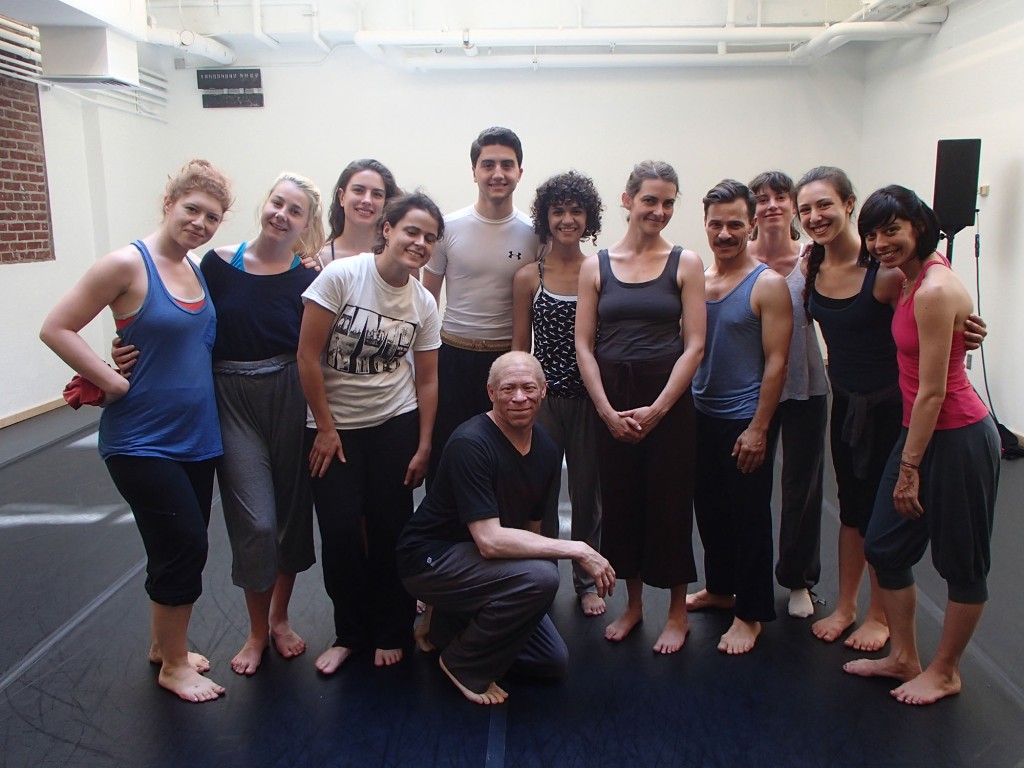
TBDC Summer Intensive students with Company alumnus Keith Thompson.
My impression of the works was further enhanced when I watched them in performance with full costumes, lights, and set. Trisha valued the visual design elements of dances as much as she did the movement — collaborating frequently with artists such as Robert Rauschenberg and Donald Judd — and her choreography breathed a new light with the integration of additional production elements. I saw the program three times, and each time I noticed something new, but also recognized familiar moments or images. I’ve grown to admire this about Trisha’s work: her dances have multiple layers, but follow a cohesive line that runs parallel to the surprising twists and turns.
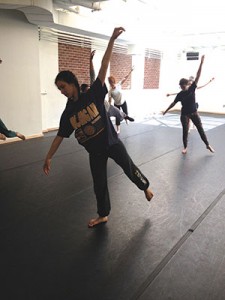
Dancing a part of “Newark” at the TBDC Summer Intensive.
After our weekend at Bard, I parted ways with the company. I returned to New York to serve as the on-site coordinator for the TBDC Summer Intensive, a three-week workshop that offered up to six hours of technique, repertory, and composition classes each day. I acted as a point of reference for students and teachers and was also able to dance! Classes allowed me to further explore the works I had grown to know intimately as an audience member, and to embody the movement that I only saw and read about up until this point. Composition/improvisation class revealed the techniques behind choreographic concepts I had observed in Trisha’s work and allowed me to apply them to my own dance making. Some of what I learned will surely find its way into the work I create for my Senior BFA Concert this coming April!
In August, I reunited with the company for my second tour experience of the summer, a performance of Trisha’s Early Works at the Lynden Sculpture Garden in Milwaukee, WI. Before she began choreographing larger works such as “Set and Reset” for the proscenium stage, Trisha concentrated on shorter, site-adaptive dances for alternative venues such as museums, rooftops, and parks. The company performs these works for events throughout NYC and international tour venues and will continue to concentrate on these types of performances after the conclusion of Proscenium Works, 1979-2011.
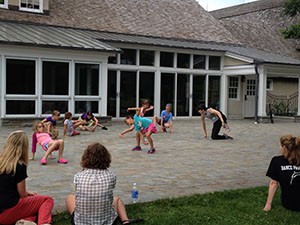
TBDC dancer Tamara Riewe leads young members of Lynden’s summer camp in demonstrating poses inspired by the sculptures in the garden.
This trip to Milwaukee marked my first foray into site work, and I quickly learned how much extra effort must go into presenting dance in any area other than a stage. We spent the first day at the Garden traveling from spot to spot, considering which dances would work best in front of which sculptures, identifying the strongest vantage points, and mapping a path for the audience to travel between locations. Since all the company members were not present for the initial site visit, I often assumed the role of a stand-in to help the team visualize dances in different locations. I was able to try some of Trisha’s choreography and tasks on site, doing her signature “Group Primary Accumulation” while floating on a raft in the middle of a pond and walking down the side of a tree for “Spiral.”
Trisha’s Early Works are full of these fun tasks and were an absolute blast to watch in performance. In one work titled “Sticks,“ dancers moved through a series of postures while balancing long, wooden sticks on their heads. This lighthearted performance atmosphere contributed to the informal relationship established between the dancers and audience. Throughout the performance, the dancers interacted with us, acknowledging when something wasn’t working and inviting us to join in on their fun. This, I discovered, was a delightful difference between the Early Works and Proscenium Works programs, the latter of which demonstrates a traditional separation between performers and audience.

TBDC members perform Sticks at the Lynden Sculpture Garden in Milwaukee, Wisconsin.
Seeing the Early Works really sparked my interest in dance for alternative spaces, which I’ve been exploring since I’ve returned to Michigan. This marks one of the many ways that my travels with the company influenced my impressions of Trisha’s work and view of the dance field. I grew leaps and bounds throughout the summer, but my experience would not have been complete without the opportunity to climb in a van with 11 professional dancers or to walk down the side of a tree in front of the company’s associate artistic director. I began my rich and unique experience as an intern “embedded” with the company, but emerged as a knowledgeable, conversant member of the TBDC family.
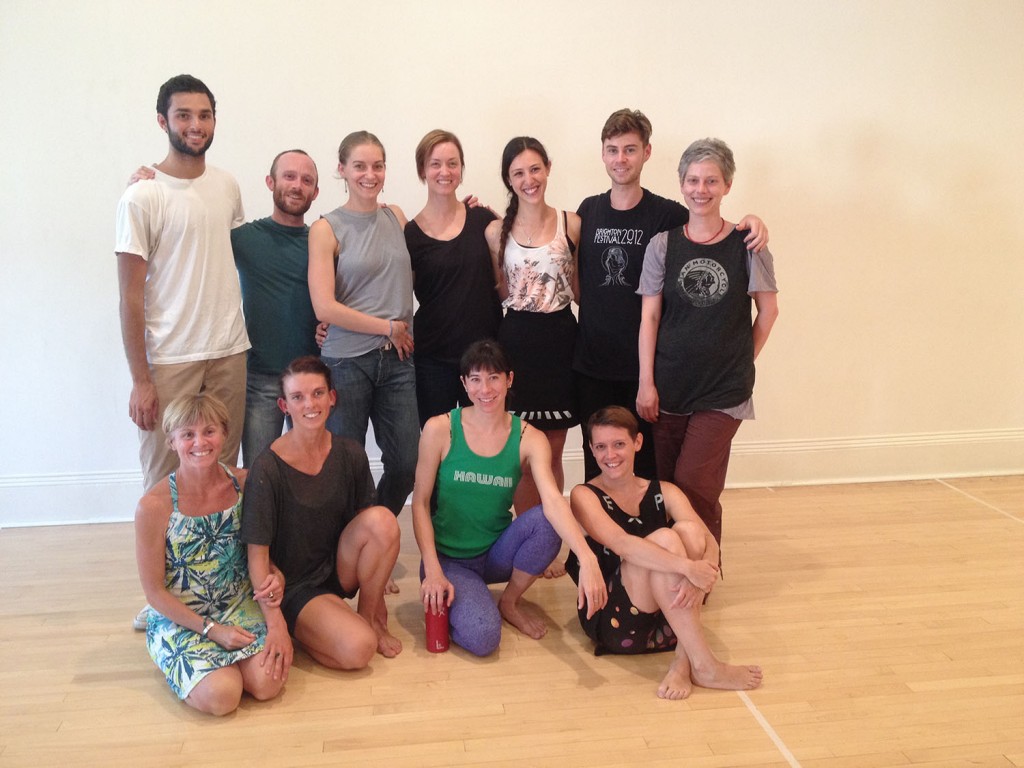
Smiling with Carolyn Lucas, Diane Madden, and the TBDC company members. Thank you for a wonderful summer!
Student Spotlight: Keeping Up with Kyle Abraham
Editor’s note: During the summer of 2014, UMS launched a new 21st Century Artist Internships program. Four students interned for a minimum of five weeks with a dance, theater, or music ensemble that is part of our 2014-2015 season. Sophia Deery is one of these students. She spent the summer in New York with Kyle Abraham and his company Abraham.In.Motion and recounts her experiences below. Abraham.In.Motion brings their innovative choreography to UMS on March 13-14.
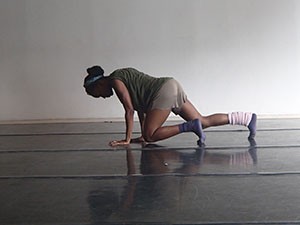
Tamisha Guy rehearses “When The Wolves Came In,” which partially draws inspiration from a tragic accident involving wild African dogs at the Pittsburgh Zoo in 2012.
“Sister Sophia!” Sister Sophia – that’s me. “Sister Sophia, could you come here and film this run?” That’s Kyle Abraham, founder, choreographer, and dancer of Abraham.In.Motion, the NYC based-dance company which emerged on the scene in 2006, and became one of the hottest tickets in the city this season with its critically acclaimed two-night program at New York Live Arts in September. I was able to intern with Kyle and the company from July through August of this past summer under the auspices of the newly created 21st Century Artist Internship through the University of Michigan’s University Musical Society. This was a fascinating time to be with the company, not only because it immediately preceded their NYC premiere of The Watershed, and When the Wolves Came In, and would involve helping to plan a major European tour, but because it was – and still is – a time when the company itself was undergoing a major internal transformation.
I came to AIM as they were nearing the end of their two-year residency at New York Live Arts. The residency is a valuable one. It allots a space and funding for a given artist to develop and perform new works in a beautiful building in Chelsea which houses a full theater, offices, and several state of the art studios. For those not familiar with New York Live Arts, it is a non-profit organization that was the result of a 2011 merger between the renowned Bill T. Jones/Arnie Zane Dance Company and Dance Theatre Workshop. In addition to this residency, Kyle had received a MacArthur “Genius” fellowship in 2013, and the company was changing shape from a pick-up model where dancers would work on a project-by-project basis, to a resident company. The difficulty is if you want dancers to make your company their priority, you have to enable them to support themselves. I had the invaluable opportunity to sit in on many meetings about budgets, the hiring of new dancers and staff members, ideas for social media campaigns, and the scheduling of performances that seemed incredibly far into the future. My own administrative tasks included writing up and sharing weekly rehearsal schedules and booking locations for the rehearsals at various dance spaces all over the city… all the while staying in budget. What I witnessed on the administrative side of the internship was, in essence, the growing pains and excitements of a small dance company, moving up to take its place as a major player in the dance landscape.
“I hope it’s good.” Kyle says to me, stretching out across the marley floor, sock-feet splayed, eating the chicken salad I had picked up for him. Rookie-intern that I am, I had made the mistake of forgetting a fork, necessitating a second trip down 6 floors and across the street, back to the deli where the cashier already thought I was crazy for spending 15 minutes trying to decide if I should get regular chicken salad, because they didn’t have the curried kind he had asked for. (The regular was fine, it turned out). I have learned a lot of things about Kyle from working as his intern. He is a very picky eater, enjoys Auntie Anne’s pretzels (original salted) and lemonade, and hates cheese. “I hope it’s good” was not referring to the chicken salad, however, but to the two programs he was rehearsing that day for their upcoming premiere. His openness and self-deprecation leave me wondering if he really cannot see the power of the piece that has left me breathless even after the tenth run. I have learned that it can be hard directing a company of dancers, now no longer all people with whom you graduated from college, but a new, younger group who look to you as a leader. He navigates a fine line between knowing when to adhere to divisions of authority structure that divide dancer and choreographer or artistic director, and when relaxing these divisions and goofing around is essential to group cohesion. I have learned that Kyle likes to send emails ending in a inscrutable “…” which leaves the recipient slightly panicked, wondering exactly what that last implied piece of information was…
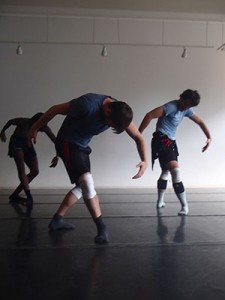
Long-time company member, and newly appointed company liaison Matthew Baker (an Ann Arbor native!) leads auditioning dancers through choreography.
“Sister Penda!” Kyle calls in a laid-back drawl, as dancer Penda N’diaye makes her way over. Kyle’s speech alternates between a familiar, affectionate, urban drawl tinged with the occasional “y’all,” which he uses with his dancers, and rapid, academic articulation when he talks about his ideas, inspirations, and influences. These are many, and indicate a cultural and artistic literacy that is wide as it is deep. Born and raised in Pittsburgh and immersed in urban youth street culture, educated at SUNY Purchase where he studied classical and modern dance, then to NYU where he received an M.F.A., a former classical cellist and briefly an employee at the Andy Warhol museum, Kyle’s education, much like his choreography, follows no conventional pattern. Additionally, he is a black, homosexual man, at a time in our country’s history where we are still deciding exactly what it means to be both. It is no doubt because of this unconventional path that Kyle’s choreography incorporates such a variety of styles (ballet, hip hop, contemporary, Graham, etc.), subject matter (Emancipation Proclamation, identity, modern sexuality, apartheid, protest), music (Max Roach, Robert Glasper, Drake, Italian Opera) – and despite the incredible breadth of its spectrum, it always rings true. Every piece comes off like a first person account of a real life experience. Like his speech, they are unaffected, but very effective.
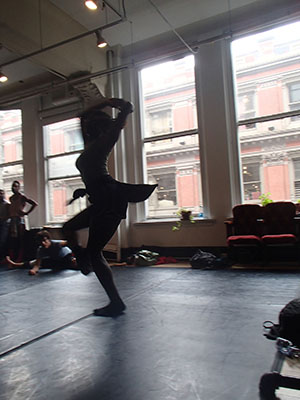
New A.I.M. dancer, statuesque Penda N’diaye, practices on the side during a rehearsal at Gina Gibney Studios.
Kyle expects this same malleability and authenticity from his dancers. His auditions, which I was fortunate enough to witness rather than experience, are a grueling process. When I asked Kyle what he looks for in a dancer, hoping honestly to get some inside-scoop for when I’m back in New York, he said that he looks for someone with dance ability and/or training across several techniques like Graham, Limon, classical ballet, Horton, hip hop, etc. As he ticked off historic dance makers and various techniques, I thought of how broad a dancer’s education has to be nowadays in order to remain competitive and successful in the field. They have to take direction which morphs technical terms like “a la second leap and then lateral T” immediately followed by “hood rat, booty poppin’, gum chewing” into “soldier walks.” This is not a one-trick pony company; indeed fewer and fewer are. Ballet company seasons are increasingly including works by Paul Taylor and Twyla Tharp, making dancers’ versatility vie with their perfect 32-count fouettés among their most marketable skills. Our conversation made me wonder what type of education provides this – how does the modern professional dancer train? I spoke with the company dancers about their various backgrounds and training, and found that many of them had pursued degrees in dance following high school, while others had immediately begun professional careers. Varying backgrounds aside, the common denominator for all of Kyle’s dancers is their intellect. The versatility he demands extends beyond the physical. As evidenced by the myriad sources from which he draws his inspiration, this is a company in which intelligence, and an understanding of the concept of each piece is essential to being able to perform it with integrity.
Two men lunge and shoot their arms up in a high V, fingers in a gesture suggestive of an old time cowboy at a gun show, or perhaps a gang member throwing up his allegiance, but the hands don’t stop there and move immediately into a high fifth position which then travels down the body to first position while their torsos synchronize in a liquid body roll. In my favorite piece, a trio called Hallowed, gospel music fills your ears as you watch three dancers alternate between a slow strut, lazily waving their arms with deadened eyes – and the rapid, aggressive arm gestures of a dance-off, eyes alive with anger or indignation. The first conjures images of paper fans, of hard church benches, of heat, and perhaps a more sinister oppression. The contrast between the two styles of movement seems to me a dramatization of the tension existent between resignation and protest.
These few examples show some of what makes Kyle Abraham unique as a choreographer: there is a story – told in recognizable pedestrian movements which are generic only in the sense that they are universal and recall things the audience has experienced, wished, or feared. Sketched situations of human existence, they allow us to do some coloring in. Seamless transitions from the pedestrian, to modern dance vocabulary, to hip hop and social dance, give the impression that Kyle is not so much juxtaposing contrasting styles of movement, or worlds for that matter, but rather elegantly weaving them together in a new type of concert dance. This is not schoolyard hip hop, nor a purist’s classical dance. While it incorporates elements of both, it also has roots in the real, the commonplace, the grit and injustice, problems we have faced in the past, and those we are grappling with now, and yet simultaneously it transcends them. At once personal and universal, and never more timely, the pair of The Watershed and When the Wolves Came In is like a diary entry written in the curves of spines, the bends of elbows and shifting patterns of light.
To view more of Sophia’s photography, see the gallery below.




